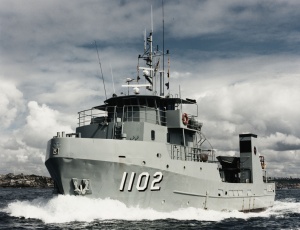MSA Brolga was purchased for the Royal Australian Navy (RAN) in 1988.
Originally named MV Lumen, it was built in Fremantle in 1975 as a lighthouse tender based at the Navigational Aids Section, Newfarm, Brisbane. In that capacity it worked mainly around Torres Island and in north Queensland waters supporting both crewed and uncrewed lights.
Lumen’s major task was the resupply of acetylene for the lights, however, as solar technology developed many of them were converted from gas to electricity and it became redundant in its support role.
 Brolga was one of 3 minesweeper auxiliaries operating as part of the Craft of Opportunity Program, alongside ships of the same class MSA Bandicoot and MSA Wallaroo.
Brolga was one of 3 minesweeper auxiliaries operating as part of the Craft of Opportunity Program, alongside ships of the same class MSA Bandicoot and MSA Wallaroo.
Throughout the remainder of its commission Brolga continued to provide the RAN with valuable service. It was involved in further mine countermeasures and trials work, boarding party training as well as participating in several major exercises along the eastern seaboard. This included the combined operations Exercise TANDEM THRUST, Australia’s major two-yearly training exercise with United States forces, conducted in the Shoalwater Bay area in Queensland. The exercise involved more than 12 000 Australian and 15 000 American personnel as well as 32 ships and 200 aircraft.
With the completion of the delivery of the 6 Huon class minehunter coastal vessels in 2002, Brolga became redundant for the second time in its life and was subsequently decommissioned and sold for $255 000. It has since returned to its port of origin in Fremantle, Western Australia.The Department of Transport and Communications consequently offered it up to open tender for disposal around the same time that the RAN’S Minesweeping Project was looking to lease vessels to trial various developmental minesweeping and surveillance equipment. An evaluation of MV Lumen presented a far more cost-effective solution and it was subsequently acquired and renamed Auxiliary Minesweeper (AM) Brolga in a ceremony at HMAS Moreton, Brisbane, on 10 February 1988.
Brolga was a steel-hulled vessel of 28.45 metres in length with a crew of 17. Throughout its commission in the RAN, it performed a variety of tasks in support of minesweeping trials and development and played a key role in the testing of the Defence Science and Technology Organisation’s Influence Minesweep in 1989. This magnetic device was designed for towing behind suitable vessels to safely detonate magnetic mines intended for use against large ships.
Brolga was based at HMAS Waterhen in Sydney and was consistently used in mine location and recovery work as part of the RAN’s mine countermeasures force.
In August 1999 it deployed to Bougainville in support of the combined Peace Monitoring Group (PMG) where it provided support to the Australian Army and PMG personnel. It arrived in the operational area on 3 August 1999 and remained there until relieved by MSA Wallaroo, another auxiliary minesweeper, on Monday 13 September 1999. It then returned to Sydney for a period of maintenance.
Brolga again deployed for operation duty in Bougainville in September 2000 in support of Operation BELISI II where it was commander of Task Group 627.9. In that capacity it provided ongoing support to numerous elements of the PMG and was frequently involved in patrol insertion and peace monitoring activities throughout the region. Brolga’s deployment to Bougainville lasted 7 months during which time its small crew was rotated several times to provide them with respite. It returned to Sydney on 13 Mar 2001 and in recognition of its efforts as part of the PMG its crews were awarded the Australian Service Medal with clasp BOUGAINVILLE.

